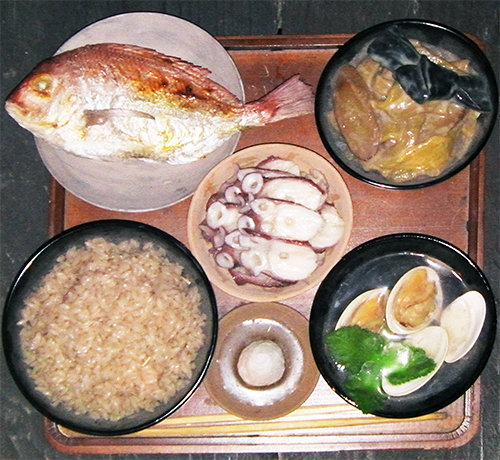

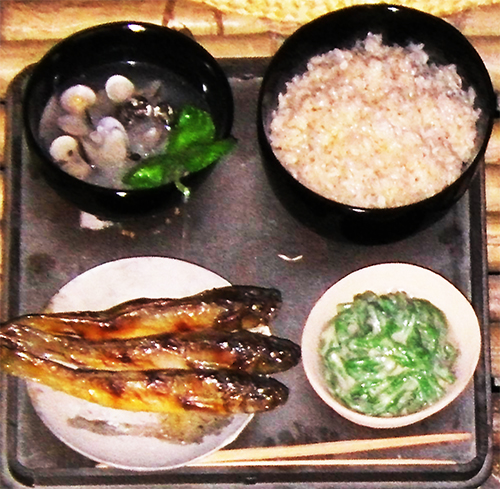
人間の基本は「なにを食べるか」。北海道島の先人のみなさんと対話するには、わたしたち現代北海道人とは違う、狩猟採集型の食生活ということを前提として知らなければならない。わたしたちはどうしてもコメ食文化がベースなので、そのあたりの翻訳コンニャクが重要ポイントになる。
今回の草戸千軒ミュージアム再訪でもこのあたりの食文化を「復元ポイント」として注目。ブログのシリーズ展開としては、ちょうど北海道島の擦文文化期からこっちにスライドしてきたので、要チェックでもありました。
そうしたら写真のようなそのものズバリの展示を確認できた。おいおい、であります。メッチャいいものを食べている(笑)。現代人以上の豊富な食材構成で栄養バランスも考え抜かれている。って、まぁ復元なので多少は「ハレの日」仕様ではあるでしょうが、大量の発掘遺物の分析からのメニュー構成であることは明らか。芦田川と瀬戸内海の水産物はそれこそ豊富に食卓を賑わせていた。タコの味付けには塩が盛り付けられている。現代では当然「しょうゆ」でしょうが、そうした醸造産業はまだ未成熟だったことでしょう。逆に瀬戸内海地域では「製塩」業は活発だった。お米は精米というよりも玄米で各家庭でそれぞれ好みの「分突き」加減で調理したのでしょう。先日見たように女性たちが臼と杵でそれぞれの家庭の加減で突きあげてご飯にしていたことでしょうね。
わたしはあんまり玄米って食べたことがないので、食感について想像力はありません。しかし、副食類は食器容器も含めてまったく現代と変わらない。中世の食卓風景、団欒ぶりが伝わってきますね。
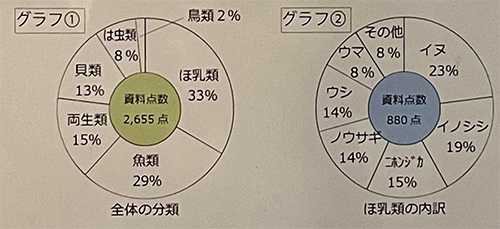
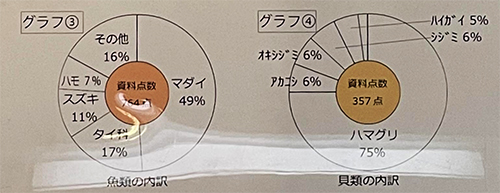
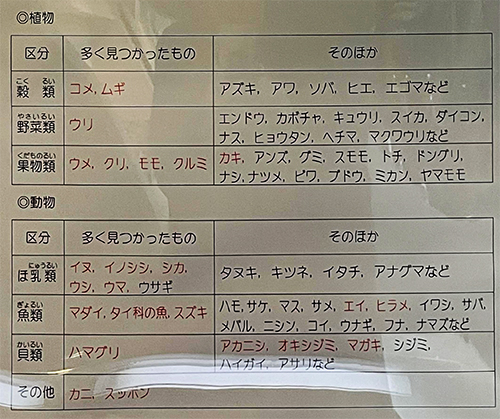
で、こちらが博物館で調査された動植物などの遺物分析の結果表。非常に注意をひかされるのが「イヌ」の骨が異常に大量に出土していることとされていた。当初は、「草戸千軒の人びとはたいへんな愛犬家ばかりですごい」みたいな想像をされていたそうですが、出土するイヌの骨があきらかに「切断」された痕跡が顕著であるとのこと。
ようするにイヌが食肉対象として飼育・捕食されていたと結論づけられていった。
おお、であります。韓半島、中国大陸ではイヌ食文化は根付いているとされるけれど、日本社会ではそういった常識理解はなかった。むしろ仏教思想が導入されて広く受け入れられていって禁忌的な考え方が浸透していたという理解だったのが、そうではなかったということになる。しかもこの草戸千軒は仏教寺院・明王院の門前市であるのでちょっと意外な事実の発掘結果だと思います。灯台もと暗し。
一方で瀬戸内海交易の世界では韓半島地域とも活発な交流が想像できるので、そういったことが影響している可能性もあるのかも。イヌ食文化痕跡にはやや驚かされました。
English version⬇
[The diet of medieval city people. Canine Eating? ~Kusado-Senken 2023 revisited-10]
Abundant marine products and brown rice with a portion for each family. The seasoning is salt. The excavation results also strongly suggest a canine food culture. The excavation results also strongly suggest the Inu food culture.
The basis of human life is “what we eat. In order to communicate with our ancestors on the island of Hokkaido, it is necessary to understand their hunter-gatherer diet, which is different from that of us modern Hokkaido people. Since we are based on a rice-eating culture, the translation of konnyaku is an important point in this regard.
In this revisit to the Kusado-Senken Museum, we will focus on this area of food culture as a “point of restoration”. As for the development of the blog series, I had just slid over here from the period of the Abrasive Culture of Hokkaido Island, so it was also important to check it out.
Then I was able to check out the very same exhibit as shown in the photo. Hey, hey, hey, hey, hey. I’m eating a lot of good food (laughs). They have a richer food composition than modern people, and their nutritional balance is well thought out. Well, it is a reconstruction, so it may be a little bit “Hare no Hi” (a special occasion), but it is clear that the menu is based on the analysis of a large amount of excavated artifacts. Fisheries products from the Ashida River and the Seto Inland Sea were abundant on the table. The octopus is seasoned with a heaping helping of salt. Today, it would naturally be “soy sauce,” but such a brewing industry would have been still in its infancy. Conversely, the “salt manufacturing” industry was active in the Seto Inland Sea region. Rice was probably unpolished rather than polished, and each household cooked rice according to their own preference for the amount of rice to be cooked. As we saw the other day, women would have pounded the rice with a mortar and pestle according to their family’s preference.
I have never eaten much brown rice, so I have no idea what the texture was like. However, the side dishes, including the containers and tableware, are not different from those of today. I can feel the happy atmosphere at the dining table in the Middle Ages.
So, here is a table of the results of the analysis of the artifacts, such as plants and animals, that were examined at the museum. It was noted that an unusually large number of “canine” bones were excavated. At first, people imagined that the people of Kusado-Senken were all great dog lovers, but the unearthed canine bones showed obvious traces of “mutilation”.
In short, it was concluded that canines were bred and preyed upon as meat.
Oh, yes. It is said that canine eating culture took root in the Korean peninsula and mainland China, but there was no such common sense understanding in Japanese society. Rather, it was the understanding that Buddhist thought had been introduced and widely accepted, and that the forbidden idea had spread, but this was not the case. Moreover, this Kusado-Senken is the gateway market of a Buddhist temple, Meio-in, so it is a somewhat surprising factual discovery result. It is dark under the lighthouse.
On the other hand, in the world of Seto Inland Sea trade, we can imagine active exchanges with the Korean peninsula area, so there may be a possibility of such an influence. I was somewhat surprised by the traces of canine food culture.
Posted on 12月 22nd, 2023 by 三木 奎吾
Filed under: おとこの料理&食, 日本社会・文化研究







コメントを投稿
「※誹謗中傷や、悪意のある書き込み、営利目的などのコメントを防ぐために、投稿された全てのコメントは一時的に保留されますのでご了承ください。」
You must be logged in to post a comment.